Police uniforms and equipment in the United Kingdom
Police uniforms and equipment in the United Kingdom have varied considerably from the inception of what were the earliest recognisable mainstream police services in the early 19th century. As various laws in the mid-19th century standardised policing in the United Kingdom, the uniforms and equipment become standardised. From a variety of home grown uniforms, bicycles, swords and pistols the British police force evolved in look and equipment through the long coats and top hat, to the recognisable modern uniform of a white shirt, black tie, reflective jackets, body armour, and the battenburg car, to the present-day Airwave Solutions radios, electric vehicles and tasers.
Police uniform and equipment varies enormously per police force or service and different uniforms and equipment is used for different situations. The lists here are not exhaustive, nor specific for each force, but give a general overview of typical uniform and equipment (colloquially known as 'kit') used in the United Kingdom.
Equipment that an officer may carry
Various items of equipment are usually carried on the duty belt of uniformed officers, although some have pouches attached to their stab vest, eliminating the need for a belt. Plainclothes officers may wear a harness, which can be worn under clothes. They usually have:
- ASP or Monadnock baton (extendable/collapsable baton)[1]
- Motorola or Sepura personal radio[2]
- CS/PAVA incapacitant spray[3]
- Police notebook
- Pens
- Smartphones, for accessing the PNC, issuing tickets and taking statements (the majority of forces)
- Torch
- Leg restraints[4]
- TCH rigid cuffs (handcuffs)[5]
- X26/X2 taser (specially trained officers, but becoming routinely issued in a few forces)[6]
Extra equipment, such as a first aid kit (including a pocket mask, disposable gloves, germicidal wipes, hypoallergenic tape, wound dressings, a triangular bandage, and sterile plasters),[7] may be stored in a patrol car.
Uniform
For much of the twentieth century up to the mid-1990s, male police officers wore a dark blue (almost black) tunic with polished silver buttons (gold for the City of London Police), and trousers of matching colour with a sewn-in truncheon pocket. No stab vest was worn and much less equipment was carried than is today. Following concerns about police officers' safety, it was suggested that the uniform should be changed.[8]
From the 1990s, it was generally accepted that the police could patrol in "shirt-sleeve order" which meant that they need not wear the jacket, as its widespread use was hampering in some situations. In 1994, the Home Office, with the co-operation of many chief constables, changed the uniform to black trousers, shirt, blue NATO-style V-neck jumper, stab vest (typically with pockets, pouches and other compartments), service belt (duty belt) and reflective jacket.
Although there are minor variations in the styling, pattern and insignia, the police forces of Great Britain, Jersey, Guernsey, the Isle of Man and Gibraltar all wear very similar uniforms. In general, these have taken their lead from the Metropolitan Police Service, due to it being recognised as the first Home Office police service in England. The base colour is a very dark blue, almost indistinguishable from black (and recently often is black), which earned the police the nickname of the "boys in blue".
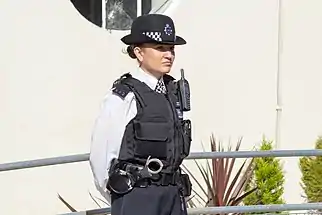
Uniform history
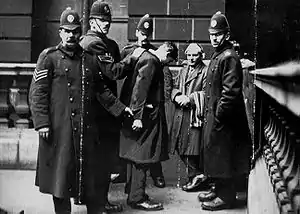
The Metropolitan Police officers were unarmed to clearly distinguish them from military enforcers, which had been the system of policing seen before the 1820s. Their uniform was also styled in blue, rather than the military red. Despite the service being unarmed, the then Home Secretary, Robert Peel, gave authorisation to the Commissioner to purchase fifty flintlock pistols, for exceptional incidents that required the use of firearms. As time progressed, the obsolete flintlocks were decommissioned from service, being superseded by early revolvers. At the time, burglary (or "house breaking" as it was then called) was a common problem for police, as house breakers were usually armed. Due to the deaths of officers at the hands of armed criminals in the outer districts of the Metropolis, and after much press coverage debating whether Peel's service should be fully armed, the Commissioner applied to the Home Secretary to supply all officers on the outer districts with revolvers. These could only be issued if, in the opinion of the senior officer, the officer could be trusted to use it safely, and with discretion. From that point, officers who felt the need to be armed, could be so. The practice lasted until 1936, although the vast majority of the system was phased out by the end of the 19th century.
From 1829, to 1839, Metropolitan Police officers wore blue swallowtail coats with high collars to counter garroting. This was worn with white trousers in summer, and a cane-reinforced top hat, which could be used as a step to climb or see over walls. In the early years of the Metropolitan Police, equipment was little more than a rattle to call for assistance,[9] and a wooden truncheon. As the years progressed, the rattle was replaced with the whistle, swords were removed from service, and flintlock pistols were removed in favour of revolvers. Initially, police constables were required to wear their uniforms at all times, whether they were on duty or not. A cloth brassard or arm band, with black and white vertical stripes, known as a "duty band", was worn on the left forearm while on duty and removed at the end of the shift. In an emergency, duty bands could also be issued as the sole item of uniform if large numbers of special constables were required. The City of London Police are the last service to use the duty band.[10]

In 1863, the Metropolitan Police replaced the tailcoat with a tunic, still high-collared, and the top hat with the custodian helmet. With a few exceptions (including the City of London Police, West Mercia Police, Hampshire Constabulary and States of Guernsey Police Service), most forces helmet plates carry a Brunswick star. The helmet itself was of cork-faced with fabric. The design varied slightly between services. Some used the style by the Metropolitan Police, topped with a boss, while others had a helmet that incorporated a ridge or crest terminating above the badge, or a short spike, sometimes topped with a ball. Luton Borough Police (1876-1947) wore a straw helmet in a similar style to the Bermudan police helmet, with a small oval plate. During WW2, all police services wore a plain peaked cap, or a military style steel helmet when appropriate.
The tunic went through many lengths and styles, with the Metropolitan Police adopting the open-neck style in 1948 (although senior and female officers adopted it before that time). Senior officers used to wear peaked pillbox-style caps until the adoption of the wider peaked cap worn today. The custodian helmet was phased out in Scotland in the early 1950s.
Female officers' uniforms have gone through a great variety of styles, as they have tended to reflect the women's fashions of the time. Tunic style, skirt length and headgear have varied by period and force. By the late 1980s, the female working uniform was identical to the male uniform, except for headgear and sometimes neckwear.
Current uniform
See also: Special Constabulary#Uniform and insignia and Police community support officer#Uniform and equipment
Full Ceremonial
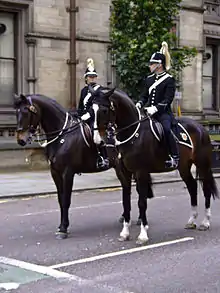
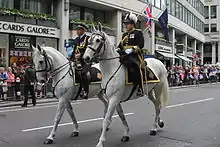
Certain officers, in certain positions wear what is known as 'full dress' i.e. a dress above and smarter than the usual No. 1 tunic style. Examples include the mounted police of the Greater Manchester Police and of the Merseyside Police who wear a ceremonial uniform which includes a distinctive cavalry-style helmet, similar to those worn by the Household Cavalry. Mounted police in Cleveland Police wear a similar uniform, but with a red rather than a white plume.[11]
Other examples include escorts to civic officials in a ceremonial capacity, such as the Lord Mayor's Mace Escort of Avon and Somerset Constabulary[12] who wear Victorian style uniform tunic, white gloves, wide leather belts with a fitting for an oil lantern and spit and polished boots with British service pattern helmets with silver trim worn in the high slung position.[12]
The commissioners and other senior-ranked officers of the Metropolitan Police and the City of London Police wear a full dress ceremonial uniform on state and special occasions. This includes a high-necked tunic with silver or gold trimmings and is worn with a sword and a cocked hat.[13]
Mess Dress
Police officers may wear mess dress to formal dinners if appropriate but this is most usually worn by officers who have achieved the rank of superintendent or above. The mess dress of the Metropolitan Police is dark blue with black cuffs and a black 'roll' collar having an embroidered Brunswick star on each lapel. That of the Commissioner includes a two-inch oak leaf lace strip on the trousers and a set of aiguillettes.[14] A matching black waistcoat is worn and badges of rank are displayed on the epaulettes.[15]
No.1 dress
.jpg.webp)
Formal uniform comprises an open-necked tunic (with or without an attached belt, depending on the force and rank of the officer) and trousers or skirt, worn with a white or light blue shirt and black tie (usually clip-on, so it cannot be used to strangle the wearer). Although most forces once wore blue shirts, these have been less used since the 1980s, and most now wear white. Officers of the rank of inspector and above have always worn white shirts, and in many forces so have female officers. In some forces, female officers wear a black and white checked cravat instead of a tie. Officers of the rank of inspector and above wear rank badges on the epaulettes or shoulders of their tunics and shirts, while constables and sergeants also wear "collar numbers" on them. Sergeants wear their chevrons on both upper sleeves of the tunic and also on the epaulettes of their shirts. No.1 dress is worn with black, polished shoes or boots. Male constables and sergeants in English and Welsh forces wear the custodian helmet with this dress, whereas the peaked cap is worn by inspectors and above (and often by all officers when travelling in cars). In Scotland, all male officers now wear a peaked cap. Female officers of all forces now wear bowler hats. At more formal occasions, such as funerals and parades, white gloves are worn.
Working dress
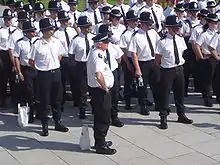
Until 1994, the formal uniform was also the everyday working uniform (although in later years sometimes worn with a jersey instead of a tunic), but today it is rarely seen except on formal occasions. The normal working dress retains the shirt and trousers. In some forces, short-sleeved shirts may be worn open-necked. Long sleeved shirts must always be worn with a tie or cravat, worn with or without a jersey or fleece. If a jersey, fleece, or jacket is worn over a short-sleeved shirt, then a tie must be worn.
In 2003, Strathclyde Police replaced the white shirts with black wicking T-shirts for the majority of officers on duty, and this dress has now been adopted by all forces except those in London, Merseyside and Northern Ireland. Some forces use combat trousers (trousers are of a cargo pocket style with two thigh pockets and two conventional side and rear pockets) and boots. Today, female officers almost never wear a skirt in working dress, and sometimes wear trousers in formal dress as well. Officers also frequently wear reflective waterproof jackets, which have replaced the old greatcoats and cloaks traditionally worn in inclement weather. Most officers now wear stab vests, a type of body armour, when on duty.
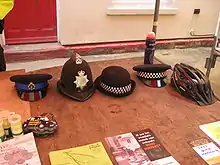
Headgear
Peaked caps and bowler caps are the basic headgear for police officers: a peaked cap for men, and a round bowler style hat for women. All officers wear a black and white (red and white for the City of London Police, blue and white for Cathedral Constables) diced band (called Sillitoe tartan) around the hat, a distinction first used in Scotland and later adopted by all forces in Great Britain. Traffic officers wear white cap covers.
The custodian helmet is worn on foot duty by male constables and sergeants (outside Scotland). There are several patterns, with different forces wearing different types. Although some Scottish forces have used helmets in the past, they are no longer worn in Scotland. Thames Valley Police abandoned the custodian helmet in 2008 due to budget cuts, but brought them back into service in 2018 due to high demand, instant recognition and popularity with police officers and the public.[16][17]
Baseball caps In addition West Yorkshire Police in 2015 and Cheshire Police in 2016 removed the Custodian helmets, with Cheshire replacing all headdress with baseball caps. Northamptonshire Police removed the Custodian helmet in 2017 and replaced it with a baseball cap, but removed the baseball caps in 2018 and brought back the Custodian helmets.[18]
This means that for the four forces (as of 2020) that removed the Custodian helmets, two forces (Thames Valley and Northamptonshire) reversed their decision and re-introduced the Custodian helmet, which has been worn across Great Britain (and some Overseas Territories) for the last century and a half.
West Yorkshire Police and (from May 2018) Hertfordshire Constabulary give female officers the option to wear a peaked cap instead of a bowler if they prefer to do so.
Other headgear are authorised for by some forces for some officers in certain situations:
- Warm 'wooly' hat
- Baseball cap
- Bicycle helmet.
For PCSOs and police staff male members wear peaked caps, with various styles of capband and capbadge and female members wear bowler caps with various styles of capband and capbadge. Both make it clear that the wearer is either a PCSO or member of police staff.
Headgear is worn when in uniform and outside (or sometimes when on official duty inside, such as patrols inside the Houses of Parliament).
Below is a table showing the standard headwear for uniformed police officers, however they may vary between forces from this table as discussed above.
| Rank insignia for Great Britain Police officer headwear | ||||||||||||
|---|---|---|---|---|---|---|---|---|---|---|---|---|
| Rank | Chief constable | Deputy chief constable | Assistant chief constable | Chief superintendent | Superintendent | Chief inspector | Inspector | Sergeant | Constable | Police community support officer | ||
| Commissioner | Deputy commissioner | Assistant commissioner | Deputy assistant commissioner | Commander | ||||||||
| Female patrol | ||||||||||||
| Female traffic officer | ||||||||||||
| Male foot patrol |  |
|||||||||||
| Male mobile patrol | ||||||||||||
| Male traffic officer | ||||||||||||
| Notes |
| |||||||||||
Identification
All Special Constables, Police Constables and Sergeants wear their collar number on at least one epaulette or collar (depending on order of dress). Inspectors and above, in most forces do not have identification numbers and merely display rank and name.
The Metropolitan Police approved the use of name badges in October 2003, and new recruits started wearing the Velcro badges in September 2004. The badges consist of the wearer's rank, followed by their surname. Senior officers wear these in no.1 dress, due to the public nature of their role.[19]
Northern Ireland
The uniform of the Police Service of Northern Ireland (PSNI) is bottle green, divergent from the dark blue traditionally used in Great Britain. This reflects the Irish roots of the force, which is descended from the Royal Irish Constabulary, whose uniforms were a very dark green, almost black. Although the colour remained the same, when the Royal Ulster Constabulary became the Police Service of Northern Ireland in 2001, the term "bottle green" was adopted in the place of "rifle green" as it was seen as having less of a military connotation, in keeping with the spirit of the time. The only other notable difference from the uniforms in Great Britain is that PSNI officers are issued Flak jackets in place of the stab vest normally used in Britain. The custodian helmet was never worn by either the RUC or the PSNI, although a similar design known as the "night helmet" was worn on night shifts by the RUC[20] until the early 1970s, and previously by the RIC.[21]
Personal radios
Personal radio systems were first issued to police officers and installed in police cars in the 1960s (resulting in the demise of the "police box" telephones made famous by Doctor Who). In 2004, British police forces began change radios from analogue, to digital TETRA (Terrestrial Trunked Radio) system for communications, called Airwave.
Prior to the introduction of Airwave, all police radio systems were force-specific, with limited capacity for forces to talk to neighbours or to facilitate working in groups away from the direction of the control room. Interoperability with other emergency services was also poor, and was criticised in reports after the Hillsborough and Kings Cross disasters. Most forces’ equipment could not transfer data or text messages – a growing operational requirement. Few had any form of encryption and were open to listening in by anyone prepared to buy cheap scanning equipment. In addition, almost every force had areas in which the police and other emergency services operated without effective radio coverage.[22]
By the end of 2004, the majority of the existing police radio spectrum, which was subject to serious interference in some areas, was to be withdrawn and replaced by a new spectrum of superior quality, dedicated to use by public safety organisations, on which users would be required to use digital equipment. Knowledge of this change reinforced the need, already identified by the Association of Chief Police Officers (ACPO) and the Home Office, for a new radio strategy. A Review of Radio Communications in the Police and Fire Services of England and Wales was inaugurated, a parallel review was carried out in Scotland, and the Public Safety Radio Communications Project was born.[22] The radios proved exceptional during the 2005 London bombings.
From the 1990s, officers frequently carried mobile phones in addition to their personal radio units.
Protective equipment
Firearms
- H&K G36 carbine (Heckler & Koch)
- Sig MCX carbine
- Sig SG516
- H&K G3 rifle
- Benelli M3
- H&K MP5
- Glock 17
- Glock 19
- Glock 26
- SIG Sauers
- Accuracy International L115A3
In the United Kingdom (with the exception of Northern Ireland), the majority of police officers do not routinely carry firearms. This originates from the formation of the Metropolitan Police in the nineteenth century, when police were not armed, partly to counter public fears and objections concerning armed enforcers.
However, the Ministry of Defence Police, Civil Nuclear Constabulary, Police Service of Northern Ireland, Belfast Harbour Police and the Belfast International Airport Constabulary are issued firearms as a matter of routine. PSNI officers are also permitted to carry their firearm off-duty.
Every territorial police force has a number of officers who are routinely armed in units generally called Armed Response Vehicles. Certain specialist squads, such as the Flying Squad, Special Branch, Parliamentary and Diplomatic Protection, Royal and Specialist Protection, and officers protecting airports along with government buildings, are routinely armed.
The British Transport Police have armed officers who have been specially trained in firearms operations, and were first deployed in early 2012. These officers are mainly stationed in London, and their primary focus is on the busiest stations. When they need to deploy officers outside London, they work closely with local police forces.
Other private or specialised police forces, such as ports police or parks police, are again generally unarmed in Great Britain and rely on armed support from territorial police forces, if needed.
Tasers
Until recently, Tasers were issued only to Authorised Firearms Officers, and their use of them was governed by the same rules of engagement as regular firearms. In November 2008, the then Home Secretary Jacqui Smith, announced that 30,000 non-firearms officers would be allowed to carry them.[23] The government announced funding of £8 million to purchase 10,000 Tasers for the police forces in England and Wales.[23] The Metropolitan Police commissioner announced in December 2011, that police were to be routinely armed with these weapons following the deaths of police officers earlier that month. However, as of 2020, the majority of officers in the Met are still yet to be armed with Tasers.
The use of Tasers is now governed by the Association of Chief Police Officers policy which states:
Tasers are to be deployed with Specially Trained Officers, where the authorising officer has reason to suppose that they, in the course of their duty, may have to protect the public, themselves and /or the subject(s) at incidents of violence or threats of violence of such severity that they will need to use force.
— Extended operational deployment of Taser for Specially Trained Units[24]
Tasers are regarded as prohibited weapons under the Firearms Act 1968, and their possession is an offence.[25] Police constables are exempt as Crown servants.[25][26]
Incapacitant spray
Officers may carry either a CS or PAVA (also known as Captor) incapacitant spray. Their effects are designed to be short-lived and exposure to fresh moving air will normally result in a significant recovery within 15–20 minutes. The CS spray issued by UK police services contains a 5% solution of CS whilst Captor sprays contain a 0.3% solution of PAVA. PAVA is significantly more potent than CS.[27]
Aerosol incapacitants are classified as prohibited weapons by virtue of Section 5 of the Firearms Act 1968 and possession of such sprays is therefore illegal by the general public. They may only be possessed with the authority of the Defence Council or the Scottish Ministers.[28] Police officers, as Crown servants, are exempt from the requirements of the legislation and can have lawful possession of an incapacitant spray whilst acting in their capacity as a constable or where necessary for the purposes of their duty.[26]
Batons
Until the mid-1990s, most police forces utilised a 14 inch long traditional wooden truncheon. On 20 June 1994, Home Secretary Michael Howard authorised the use of batons. Long, rigid American-style batons were then introduced, first by the Metropolitan Police and then by other forces, but in many places these were short lived, mainly due to their being unwieldy in most operational circumstances.
The use of batons varies across the country, and each force selects which baton is best able to fulfil its needs and provide the best protection to officers. Expandable batons, such as the friction lock ASP are popular, although the Monadnock PR-24 side-handle baton or the Monadnock Straight Lock baton is used in some forces. Some forces in the North of England use a one-piece "Arnold" baton, and other officers can choose to use this style of baton, after passing the appropriate training however now all police forces carry ASP, Monadnock or Casco batons.
Batons are offensive weapons; the following are offences under the Criminal Justice Act 1988:
- manufacturing,
- selling or hiring,
- offering for sale or hire,
- exposing having in your possession for the purpose of sale or hire,
- lending,
- giving to any other person, or
- importing
an offensive weapon.[29] The list of weapons regarded as offensive for the purposes of the act includes "straight, side-handled or friction-lock truncheons (sometimes known as a batons)" in the Criminal Justice Act 1988 (Offensive Weapons) (Amendment) Order 2004 and "telescopic truncheons" in the Criminal Justice Act 1988 (Offensive Weapons) Order 1988. The restrictions on the activities listed above do not apply "for the purposes of functions carried out on behalf of the Crown",[30] which includes water bailiffs, immigration officers and police constables. In addition, police constables have "lawful authority" to possess batons.[26]
Police vehicles
Ground vehicles
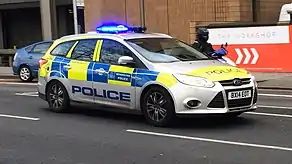
Except for rapid response units, motor vehicles were rarely used except in rural districts (and even there, bicycles were more common). However, following the 1964 Police Act, the police became increasingly motorised and it is now rare to see an officer on foot patrol except in city or town centres, and then rarely alone. More recently, police forces have begun to put officers back on the beat as 'community' or 'neighbourhood' patrols. In an increasing number of urban centres police bicycle units are used to provide a quick response in congested areas, pedestrianised areas and parkland, as well as carrying out patrols. A bicycle patrol provides a balance between the distance covered by a motorised patrol and the approachability of the foot patrol.[31] The Metropolitan Police now has over 1500 police bicycles.[32]
Incident Response Vehicles (IRV) are generally used when a '999' call has been received regarding an ongoing incident or emergency. Usually an IRV would be assigned to the call, as their continual patrol of an area reduces their deployment time. Response vehicles tend to be capable of the safe use of speed, common types include, Ford Focus, Vauxhall Astra or Vauxhall Insignia. These are usually fitted with engines with a size of around 1.6 to 2.0 litres. Although petrol-powered engines once dominated, diesel engines became more common due to their superior fuel economy and therefore lower operating costs. In urban areas, such as London, police services are returning to petrol engines (and hybrids) to combat air pollution. All new Metropolitan Police IRVs from 2018 are petrol.
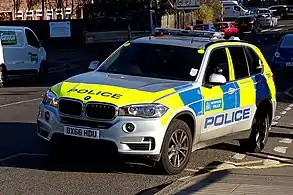
.jpg.webp)
Larger, more powerful vehicles are used by Road Policing Units and Armed Response Units due to the fact that they carry out tasks such as pursuing stolen cars, responding to emergencies in a larger area, or carrying a larger amount equipment than an IRV. It is for that reason that many of the vehicles are estates and 4x4s. Vehicles commonly used include BMW 3 Series, BMW 5 Series, BMW X5s and Land Rover Discoverys for Roads Policing Units. BMW X5s are commonly used as Armed Response Vehicles. Officers are required to be trained as 'advanced drivers', allowing them to operate higher-performance vehicles. Some advanced drivers are also trained to TPAC standard, allowing them to engage in the tactical phase of a pursuit and perform TPACs.
Most marked police vehicles are white or silver with retroreflective livery markings on the side. These markings usually take the form of a blue, yellow or red strip down the side of the vehicle, or use high visibility battenburg markings (with blue and yellow the accepted Home Office colours for police use). Some carry adverts for police initiatives, slogans such as the Metropolitan Police's "Working for a safer London" (withdrawn in 2012 following rebranding), or the service crest.
Unmarked police vehicles are used for a variety of purposes, including road policing duties. One popular vehicle for this use is the Škoda Octavia vRS which is chosen due to its high performance but conservative styling. Some police services have begun using Golf Rs and Audi RS3s for the most dangerous or challenging pursuits.
Police vans such as the Ford Transit or Mercedes-Benz Sprinter are also used and have a cage in the back for transporting prisoners.
Aircraft
Police Helicopters are required by the CAA to be marked in a standard 'high conspicuousness' paint scheme, to make them more visible and avoid the possibility of air proximity hazards with other low-flying aircraft. This paint scheme, also used by UK military training helicopters, requires them to be black on the sides and underneath, and yellow on top. When seen from the ground, these helicopters are black but this is to make them more visible against the sky as a safety feature (and yellow against the ground when seen from above). One of the most common helicopters used by the police is the Eurocopter EC135, alongside 4 EC145 used. 4 Vulcanair P.68 aeroplane are also utilised.
In England and Wales, the National Police Air Service (NPAS) operates all police helicopters and planes.[33] Police Scotland and PSNI operate their own air support units.
Overseas territories
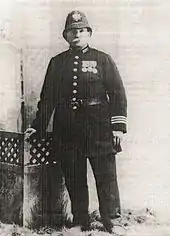
Uniform
Police organisation and uniform history has varied throughout the British Overseas Territories. Uniforms have often had to be adapted to local climates, but generally follow a pattern and common features can be seen throughout the UK and overseas territories, such as rank insignia and capbadges.
Uniform in warmer climates, such as the Caribbean area territories will wear short sleeve shirts, shorts and lighter coloured jackets, tunics and trousers. Likewise, colder climates, such as the South Atlantic, will wear long sleeved shirts, jumpers, jackets and long trousers. The territories' police forces which were active under the British Empire (as colonies, protectorates, dominions or territories) follow a typical colonial style uniform and equipment, with its somewhat paramilitary image, such as Sam Browne belts, khaki or green colour tunics and trousers and the more widespread use of firearms.
Later, with civilisation of territories' police forces, uniforms became more synonymous with British-style civilian police uniforms.
For example, the Bermuda Police Service has followed the trends of UK police forces in its dress, having adopted dark blue tunics, trousers, and helmets at its inception. After the appointment of Police Commissioner Colin Coxall, in 1995 (formerly of the Metropolitan Police), the four-pocket jackets and helmets were reserved for ceremonial or public relations occasions, with more comfortable bomber jackets and woollen pullovers adopted.
In the Bermuda Police Service, only officers wear white shirts, with sergeants and constables wearing light blue ones. During the summer months, the long trousers are replaced with Bermuda shorts. The traditional image of a Bermuda policeman in the minds of summer visitors is helmeted, with knee socks and shorts. During, and for a short time after, the Second World War, influenced by the large numbers of military personnel on the island, the Bermuda Police took to wearing military-style khaki shorts and shirts during the summer months, but this fad quickly passed.
Equipment
Overseas territories use similar police equipment to the UK:
- radios
- batons
- tasers
- breathalyser
- protective equipment
Overseas territories receive some of their equipment from the UK and British police forces.
References
- "UK | Police get stick over new batons". BBC News. 30 December 1998. Retrieved 8 May 2009.
- "Our Equipment". Limacharlie. Retrieved 8 May 2009.
- "Our Equipment". Limacharlie. Retrieved 8 May 2009.
- "Policies". Acpo.police.uk. Archived from the original on 29 April 2009. Retrieved 8 May 2009.
- "Our Equipment". Limacharlie. Archived from the original on 7 August 2009. Retrieved 8 May 2009.
- Ford, Richard (25 November 2008). "Jacqui Smith's Taser plan suffers blow after Met Police Authority's rejection". Times Online. London. Retrieved 25 November 2008.
- "England | West Yorkshire | 'Poor first aid' in shot Pc's car". BBC News. 29 May 2005. Retrieved 8 May 2009.
- "The police uniform blues?". BBC News. 5 September 2000. Retrieved 8 May 2009.
- Taylor, J. "The Victorian Police Rattle Mystery" Archived 18 February 2010 at the Wayback Machine The Constabulary (2003)
- "The Duty Band". www.ploddinthesquaremile.co.uk. Retrieved 12 March 2018.
- link to photo
- https://gmic.co.uk/topic/60678-lord-mayor39s-mace-escort/
- "Dress and Insignia Worn at Court". Retrieved 25 March 2012.
- "Mess Uniform – PoliceSpecials.com Forum". Archived from the original on 31 January 2013. Retrieved 13 February 2012.
- "Recent photo". Archived from the original on 16 July 2015.
- https://www.bbc.co.uk/news/uk-england-berkshire-43060872
- https://www.thamesvalley-pcc.gov.uk/news-and-events/thamesvalley-pcc-news/2018/03/thames-valley-police-to-bring-back-custodian-helmets<
- https://www.bbc.co.uk/news/uk-england-northamptonshire-46237062
- "Archived copy". Archived from the original on 20 February 2012. Retrieved 3 June 2014.CS1 maint: archived copy as title (link) Introduction of name badges
- http://police-museum.co.uk/displayimage.php?album=random&cat=7&pos=-958
- http://police-museum.co.uk/displayimage.php?album=random&cat=7&pos=-2446
- "Archived copy" (PDF). Archived from the original (PDF) on 22 July 2011. Retrieved 22 September 2009.CS1 maint: archived copy as title (link) Public Safety Radio Communications Project, Martha Woodbridge
- Leppard, David (23 November 2008). "Police to get 10,000 Taser guns". London: Times Online. Retrieved 8 May 2009.
- Extended operational deployment of Taser for Specially Trained Units
- Extended operational deployment of Taser for Specially Trained Units, Operational Guidance, section 5.2
- English, Jack; Card, Richard (2005), Police Law, Blackstone's Police Books, ISBN 0-19-928405-9
- ACPO Guidance on the Use of Incapacitant Spray (Printed 4 November 2010)
- "Firearms Act 1968 (c. 27)". Statutelaw.gov.uk. Retrieved 8 May 2009.
- "Criminal Justice Act 1988 (c. 33) - Statute Law Database". Statutelaw.gov.uk. Retrieved 8 May 2009.
- http://www.statutelaw.gov.uk/content.aspx?parentActiveTextDocId=2116646&ActiveTextDocId=2116824
- TFL 999 London Cycling Award press release
- "Police on bikes, from LS8". Daveches.co.uk. Archived from the original on 25 December 2008. Retrieved 8 May 2009.
- National Police Air Service
- Metropolitan Police Marine Unit Archived 20 July 2006 at the Wayback Machine
- "Strathclyde Police Marine Policing Unit". Strathclyde.police.uk. Archived from the original on 28 September 2007. Retrieved 8 May 2009.
External links
- Examples of full ceremonial dress worn by senior officers in London (as per 'Dress Worn at Court' p89ff):